|
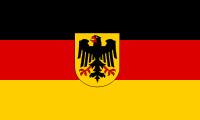 Rodderberg Vulkan Rodderberg Vulkan
Der Rodderberg ist der nördlichste und mit einem Alter von etwas weniger als 800.000 Jahren auch der jüngste Vulkan der Region. Er liegt im Südzipfel von Bonn direkt über dem Rheintal und erstreckt sich über die Stadtgrenzen bis in den Rhein-Sieg-Kreis und nach Rheinland-Pfalz hinein. Mit seinem eindrucksvollen, über 50m tiefen kreisrunden Krater mit seinen Hängen aus basaltischen Tuff und Schlacke ist er ein einmaliges geologisches Denkmal. Von mehreren Aussichtspunkten hat man eine wunderschöne Rundsicht auf den direkt gegenüberliegenden Drachenfels, die Stadt Bonn und bei gutem Wetter dem Kölner Dom.
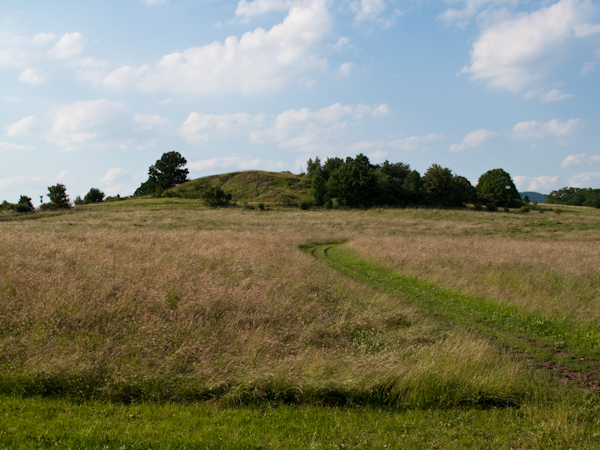
Geschichte
Vor etwa 550.000 Jahren stieg heißes Magma aus tieferen Regionen auf. Als es das oberflächennahe Grundwasser erreichte, kam es zu einer gewaltigen phreatomagmatischen Explosion, die den heute etwa 50m tiefen Maarkrater bildete. Der Krater hat einen Durchmesser von ca. 800m und ist aus der Luftperspektive immer noch gut sichtbar.
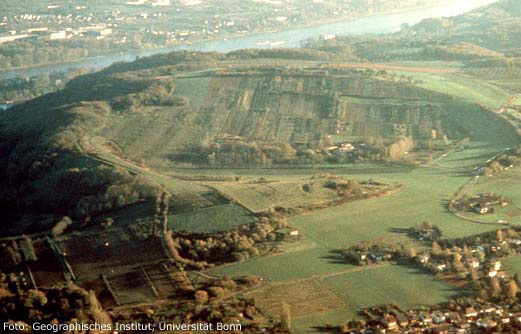
Etwa 300.000 Jahre später erwachte der Rodderberg erneut zum Leben. Diesmal mit einer Serie von Schlackeneruptionen. Ein besonders gut sichtbares Zeugnis einer dieser späteren Eruptionen ist eine mit Lava gefüllte Spalte die in der Nordgrube in Schlackenablagerungen eindrang. Die Schlacke wurde abgebaut und der Basaltgang blieb wegen seiner größeren Härte stehen. Er kann noch heute an dieser Stelle bewundert werden.
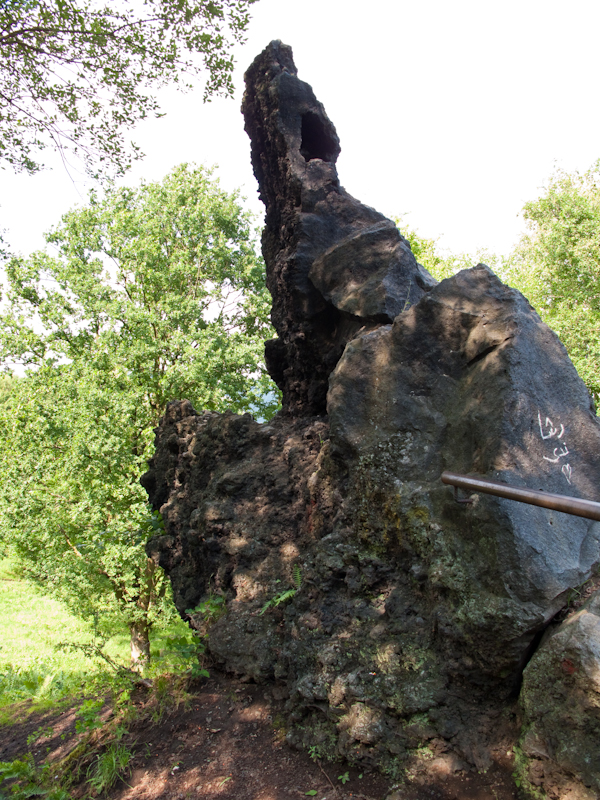
Phreatomagmatische Explosion
Eine phreatomagmatische Explosion kann stattfinden wenn Wasser in direkten Kontakt mit Magma, Lava oder heißen pyroklastischen Dichteströmen gerät. Der schlagartig entstehende Wasserdampf mit ungefähr dem 1000-fachen Wasservolumen zertrümmert das umgebende Gestein und sprengt einen Krater in den Gesteinsuntergrund. Das ausgeworfene Tuffmaterial, das in manchen Fällen fast gänzlich aus zertrümmerten nichtvulkanischem Nebengestein besteht, wird rings um den Krater als Wall abgelagert. Dieser Eruptionstyp gilt als der typische Bildungsmechanismus für Maare.
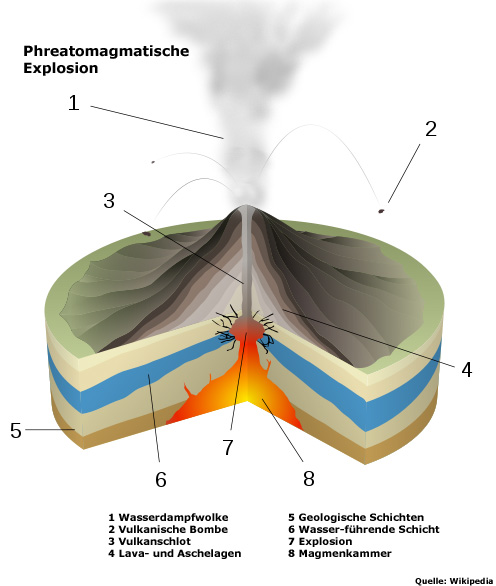
Der Rundweg
Falls ihr etwas Zeit habt empfehlen wir euch wärmstens den schönen Rundweg am Kraterrand. Den Rundweg könnt ihr auf GPSies anschauen.
Die Fragen
Bitte begebt euch an die oben genannte Koordinate. In der Nähe befindet sich eine Informationstafel (siehe Wegpunkt). Lest euch die Tafel bitte sorgfältig durch und beantwortet folgende Fragen:
- Bis wann wurde die Schlacke an diesem Ort abgebaut?
- Zu welchem Zweck wurde die Schlacke verwendet?
- In welcher erdgeschichtlichen Epoche ereignete sich eine gewaltige Explosion?
Nenne die Anzahl der Bilder auf der Tafel und beschreibe kurz was du auf ihnen siehst.- In welchem großräumigen Zusammenhang steht der Rodderberg?
Achtung!Es werden genau die Angaben gesucht, die auf der Tafel gemacht werden! Internet Lösungen können leider nicht bis eine neue Tafel installiert wurde akzeptiert werden.
Die Log-Bedingungen
- Bitte schickt uns eine Email mit den Antworten für die Fragen.
Sehr Wichtig! Bitte gebt im Betreff den EarthCache Namen und euren GC Namen mit an!
- Bitte macht freiwillig ein Bild von euch oder eurem GPS vor dem Basaltgang und fügt es eurem Log-Eintrag hinzu.
Ihr könnt dann sofort loggen.
Falls etwas nicht richtig ist, werden wir uns bei euch melden!
Wir hoffen euch macht dieser EarthCache und der Rundweg genau so viel Spaß wie uns! Wir danken euch für euren Besuch und freuen uns auf eure Emails!
Liebe Grüße Kate!
Waymarking
In Kombination mit dem Cache kann auch der Waymark WM6TDF gelogged werden.
 Rodderberg Volcano Rodderberg Volcano
The Rodderberg is the most northern and with an age of a little less than 800.000 years also the latest volcano of the region. Located in the South of Bonn, directly above the Rhine Valley it stretches over the town borders till the Rhein-Sieg-Kreis and to Rhineland-Palatinate. With its impressive, more than 50-m-deep perfectly circular crater with its slopes from basaltic tuff and slag it is a unique geologic monument. From several vantage points one has a wonderful round view on the directly subtending dragon's rock, the city of Bonn and in good weather to the Cologne Cathedral.

History
About 500.000 years ago, hot magma rose from deeper regions. When it reached ground water close to surface, it came to an immense phreatic eruption which formed the maar crater, nowadays about 50 m deep. The crater is approx. 800 m in diameter and is still well visible from the aerial perspective.
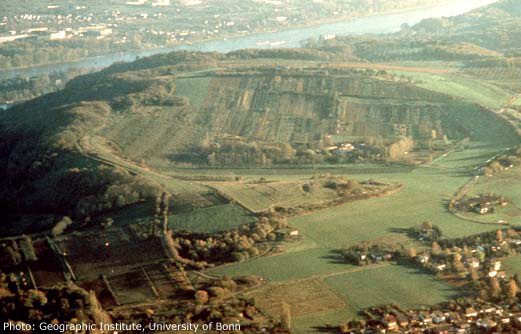
About 300,000 years later the Rodderberg awoke once more to life. This time with a series of slag eruptions. An especially well visible report of one of these later eruptions is a column full with lava, that forced its way into slag deposits in the northern pit. The slag was degraded and the basaltic dike persisted by reason of its bigger hardness. It can still be admired in this place.

Phreatic Eruption
A phreatic explosion can take place if water gets in direct contact with magma, lava or hot pyroklastic density streams. The abrupt arising steam with the about thousandfold water volume smashes the surrounding rock and bursts a crater into the rocky subsoil. Being in some cases almost totally from smashed non-volcanic adjoining rock, the ejected tuff material is deposited all around the crater as an embankment. This eruption type is recognized as the typical formation mechanism of maars.

The loop road
If you have some time we highly recommend the pleasant walk on the loop road at the edge of the crater. You can watch it on GPSies.
Questions
Please, head for coordinate mentioned above. Thereabouts is an information board (watch out for the waypoint). Read the board carefully by and answers the following questions:
- Until when was the slag diminished at this place?
- What was the slag used for?
- In which geological epoch happened an immense explosion?
Name the number of the pictures on the board and describe shortly what you can see on them.- In which extensive connection over whide areas stands the Rodderberg?
Attention!The precise details are required, provided on the board! Unfortunately, solutions found in the internet cannot be accepted until a new information board is available..
Log terms
- Please send us an e-mail with the answers to the questions. Please wait for approval Email before you make your log. Important! Please add your GC Name to Email Subject!
- Please take a optional picture of you or your GPS in front of the basaltic dyke and add it to your log.
Logs without approval Email will be deleted without comment.
We hope you will enjoy this EarthCache and the loop road as much as we do. We thank you for your visit and are looking forward to your e-mails!
Kind regards, Kate!
Waymarking
In combination with this cache you can log Waymark WM6TDF.
Statistik / Statistics
Historie / History
- 21.06.2009 Listing erstellt. / Listing created.
- 29.06.2009 OpenCaching Link hinzugefügt. / OpenCaching link added.
- 19.07.2009 Waymarking Hinweis hinzugefügt. / Waymarking info added.
- 19.07.2009 Log-Bedingungen geändert. / Log terms changed.
- 08.12.2010 Geocoin entfernt. / Geocoin removed.
- 23.01.2011 Bild optional. / Picture optional.
- 17.07.2011 Log Bedingungen vereinfacht. / Log terms simplified.
- 12.05.2012 Einige URL's entfernt. / Some URL's removed.
- 13.05.2012 Opencaching entfernt. / Opencaching removed.
|